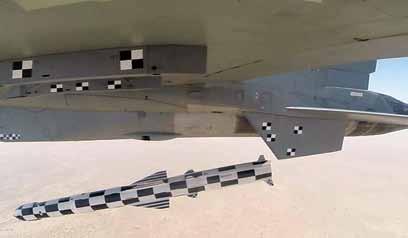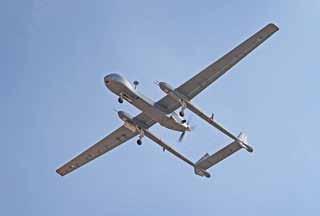Aero India 2021
SPECIAL REPORT
(left) BrahMos Launched from a Su-30MKI; (right) LCA Tejas
Atmanirbhar Bharat: Aiming to Achieve the Optimal Strength for the Country “When India speaks of becoming self-reliant, it doesn’t advocate a self-centred system. In India’s self-reliance, there is a concern for the whole world’s happiness, cooperation and peace” —Narendra Modi, Prime Minister of India Air Marshal Sukhchain Singh (Retd)
www.spguidepublications.com
A
tmanirbhar Bharat, a self-reliant policy does not aim to be protectionist in nature. The Finance Minister said, “self-reliant India does not mean cutting off from rest of the world”. The Law and IT minister, Ravi Shankar Prasad, said that self-reliance does “not mean isolating away from the world. Foreign Direct Investment is welcome, technology is welcome, self-reliant India translates to being a bigger and more important part of the global economy.” Further, in May 2020, Prime Minister Modi laid down the five pillars of ‘Atmanirbhar Bharat’. These are economy, infrastructure, technology-driven systems, vibrant demography and demand. Defence sector has been identified as one of the core areas to boost ‘Make in India’ where immediate transformation is required. A vision of achieving five billion dollars (`35,000 crore) defence related exports target to become net exporter of defence equipment in the next five years. In August 2020, Defence Minister Rajnath Singh announced that the Defence Ministry is “now ready for a big push to Atmanirbhar Bharat initiative” by imposing an “import embargo on 101 items” in a staggered manner over a period of five years. The Defence Production and Export Promotion Policy (DPEPP 2020) and Defence Acquisition Procedure 2020 (DAP) aims towards self-reliance. The DPEPP 2020 policy aims at providing greater visibility of Armed Forces requirements to the defence manufacturing industry. Under this policy, export target has been set as 25 per cent of the revenue. By 2025, this policy aims at achieving `1.75 lakh crore in annual turnover.To promote Atmanirbhar Bharat in the defence manufacturing, a separate budget of `52,000 crore has been set aside for procurement from domestic vendors. Speaking on MoD issuing a negative list of 101 defence items on the valuable suggestion of Prime Minister Narendra Modi, Rajnath Singh said, “After a certain period of time these items will not be procured from outside. This list is the beginning of a process that has the potential to transform the defence industry. This list of 101 items includes not only minor parts but also warfare systems, integrated platforms, combat vehicles. This list is just a beginning, so that in the coming time, defence equipment worth `1.40 lakh crore will be purchased domestically.” The government has made several bold policy reforms to promote self-reliance, in the defence sector. These include increasing the limit to 74 per cent for Foreign Direct Investment through automatic route in the Defence sector and setting up of Defence corridors in UP and Tamil Nadu in addition to Strategic Partnership (SP) Model to promote investments, liberalisation of Industrial License regime, and ‘Defence Investor Cell’ to address the problems of investors. Corporatisation of Ordnance Factory Board (OFB) would be completed within a year. and the two Defence Industrial Corridors in Uttar Pradesh and Tamil Nadu were targeted to attract 20 thousand crores of investments in the next five years. The Journey with a Purpose Atmanirbhar Bharat will allow a focussed and aggressive approach of all the stakeholders that includes all the three Services, MoD, DRDO and industry to energise strategies in developing niche technologies and promote a culture of innovations. Development of a large eco system with well-defined role for all stake hold-
ers/ MSMEs as tier-II / tier-III suppliers, start-ups and academia as innovators, industry houses as aggregators, testing & quality assurance services providers is expected to be the outcome of the synergies so developed. Hopefully, this will propel India as an integral part of Global Supply Chain and top- class destination for manufacture of defence equipment. India needs to develop world class testing and evaluation infrastructure by utilising existing infrastructure with DRDO and private industry to remain relevant and competitive in this global chain. Atmanirbhar in manufacturing and sustenance of eco system for life cycle support of indigenous equipment will be a necessity to ensure the combat capability is sustainable. As part of the journey, emphasis by the industry ought to be on co-production through joint ventures with foreign partners as well. Technology up-gradation for self-sufficiency in various fields has to be an ongoing and vigorous action. Government needs to aggressively encourage and fund Research & Innovation in the DRDO Labs, private sector and in academic institutions as well. The PM has eluded to this a number of times in his interactions with the intelligentsia. The iDEX initiative which was launched to encourage entrepreneurs particularly those associated with MSME and Start-ups, is also getting positive results. Through this platform, more than 50 start-ups have developed technology and products for military use. More needs to be done keeping the requirements of defence both in the short as well as long term projects. India has the potential to become a reliable supplier of defence equipment to many of its friendly nations. It will strengthen India’s strategic partnerships and strengthen India’s role as a “net security provider” in the Indian Ocean Region. Defence Acquisition Procedure 2020 (DAP 2020) The DAP provides that the list of items under the embargo list can be procured from an “Indian Company”. The definition of an “Indian Company” includes any company incorporated in India. Therefore, subsidiaries of foreign companies are entitled to bid under the categories reserved for the Indian market such as – Buy Indian India Design, Buy Indian and Buy and Make Indian procurements. Therefore, it now encourages foreign players to set up and manufacture their products in India. It is expected that approx. USD 60 billion will be spent by the Indian Armed Forces to procure the 101 items over the next 5–7 years. The Inter-Governmental Agreements have been specifically exempted from offset requirements. This is an important step as India moves away from buying from foreign private suppliers to buying from friendly Governments. Private parties who are sub-contractors to foreign governments stand to gain from this exception as meeting the offset requirements and actual offset implementation delays were blamed to be the bane of the Indian defence industry. Another important development is that for the first time, “leasing” has been introduced in the draft DAP 2020 as a category of defence acquisition in addition to the ‘buy’, ‘buy and make’ acquisition categories. India has previously leased submarines from the former Soviet Union and Russia. The leasing category encourages firms supplying critical equipment and weapons to enter into long term/medium term contracts. The contractor would be responsible for maintenance and repair for the duration of the contract. This may be a possible short-term solution for the Indian Armed Forces to possess and operate expensive platforms required for a limited period to avoid huge capital expenditure on outright purchase. SP’s
8 | Day 1 | FeBRUARy 3, 2021
show
news
WWW.SPsshownews.COM








